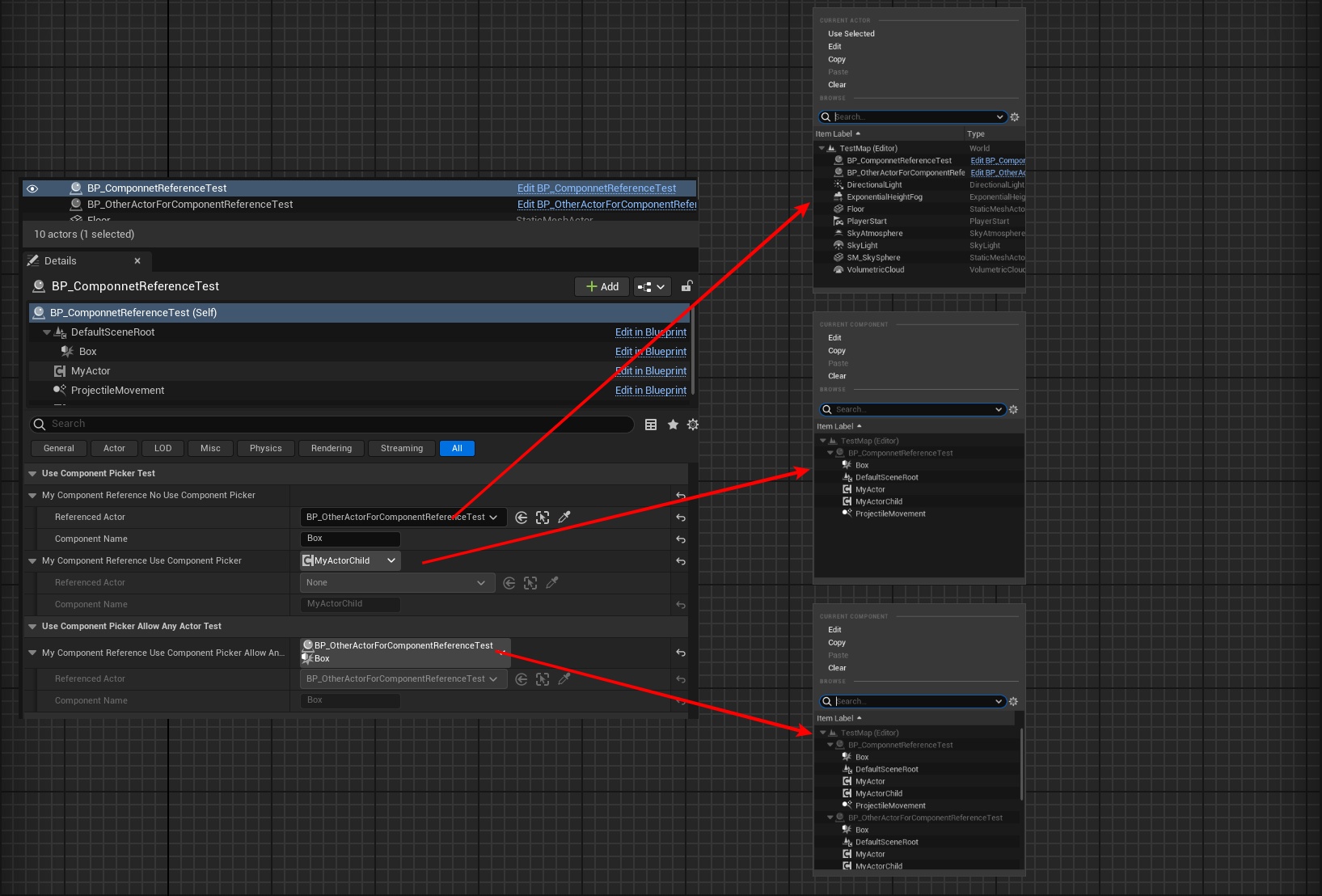4.8 KiB
4.8 KiB
UseComponentPicker
- 功能描述: 用在ComponentReference属性上,使得选取器的列表里展示出Actor属下的Component以便选择。
- 使用位置: UPROPERTY
- 引擎模块: Component Property
- 元数据类型: bool
- 限制类型: FComponentReference,FSoftComponentReference
- 关联项: AllowAnyActor
- 常用程度: ★★
用在ComponentReference属性上,使得选取器的列表里展示出Actor属下的Component以便选择。
- 默认情况下,FComponentReference的Referenced Actor属性展开的选择器列表是让你选择场景里的Actor,因此并不会把该Actor下的组件也都显示出来。而ComponentReference下的ComponentName属性需要玩家手动填写。这种方式比较原始,也容易出错。
- 因此加上UseComponentPicker后,就可以显示出组件列表来选择。但是又默认限制是当前Actor属下的所有组件,不包括场景里其他Actor里的组件。
- 如果想要进一步把场景里所有Actor下的所有组件都列出来,则需要进一步加上AllowAnyActor,以扩大筛选范围。
- ComponentReference的属性类型有两种,FComponentReference和FSoftComponentReference,二者都对应了FComponentReferenceCustomization。测试代码为简洁就没有列出FSoftComponentReference。
测试代码:
UPROPERTY(EditInstanceOnly, BlueprintReadWrite, Category = "UseComponentPickerTest")
FComponentReference MyComponentReference_NoUseComponentPicker;
UPROPERTY(EditInstanceOnly, BlueprintReadWrite, Category = "UseComponentPickerTest", meta = (UseComponentPicker))
FComponentReference MyComponentReference_UseComponentPicker;
UPROPERTY(EditInstanceOnly, BlueprintReadWrite, Category = "UseComponentPicker_AllowAnyActor_Test", meta = (UseComponentPicker,AllowAnyActor))
FComponentReference MyComponentReference_UseComponentPicker_AllowAnyActor;
测试效果:
- 可见默认的第一个列出了所有Actor,但是ComponentName需要手写。
- 第二个加上UseComponentPicker后,列出了当前Actor下的所有组件,但是不能选择到其他Actor的组件。
- 第三个继续加上AllowAnyActor后,列出了所有Actor的所有组件。
原理:
FComponentReference和FSoftComponentReference,二者都对应了FComponentReferenceCustomization。看源码可发现用上bUseComponentPicker后,会专门创建ClassFilters和ComboBox,就是采用不同的类型过滤器和不同的UI来选择组件。否则else分支就是很朴素的结构属性展开编辑。
void FComponentReferenceCustomization::CustomizeHeader(TSharedRef<IPropertyHandle> InPropertyHandle, FDetailWidgetRow& HeaderRow, IPropertyTypeCustomizationUtils& CustomizationUtils)
{
PropertyHandle = InPropertyHandle;
CachedComponent.Reset();
CachedFirstOuterActor.Reset();
CachedPropertyAccess = FPropertyAccess::Fail;
bAllowClear = false;
bAllowAnyActor = false;
bUseComponentPicker = PropertyHandle->HasMetaData(NAME_UseComponentPicker);
bIsSoftReference = false;
if (bUseComponentPicker)
{
FProperty* Property = InPropertyHandle->GetProperty();
check(CastField<FStructProperty>(Property) &&
(FComponentReference::StaticStruct() == CastFieldChecked<const FStructProperty>(Property)->Struct ||
FSoftComponentReference::StaticStruct() == CastFieldChecked<const FStructProperty>(Property)->Struct));
bAllowClear = !(InPropertyHandle->GetMetaDataProperty()->PropertyFlags & CPF_NoClear);
bAllowAnyActor = InPropertyHandle->HasMetaData(NAME_AllowAnyActor);
bIsSoftReference = FSoftComponentReference::StaticStruct() == CastFieldChecked<const FStructProperty>(Property)->Struct;
BuildClassFilters();
BuildComboBox();
InPropertyHandle->SetOnPropertyValueChanged(FSimpleDelegate::CreateSP(this, &FComponentReferenceCustomization::OnPropertyValueChanged));
// set cached values
{
CachedComponent.Reset();
CachedFirstOuterActor = GetFirstOuterActor();
FComponentReference TmpComponentReference;
CachedPropertyAccess = GetValue(TmpComponentReference);
if (CachedPropertyAccess == FPropertyAccess::Success)
{
CachedComponent = TmpComponentReference.GetComponent(CachedFirstOuterActor.Get());
if (!IsComponentReferenceValid(TmpComponentReference))
{
CachedComponent.Reset();
}
}
}
HeaderRow.NameContent()
[
InPropertyHandle->CreatePropertyNameWidget()
]
.ValueContent()
[
ComponentComboButton.ToSharedRef()
]
.IsEnabled(MakeAttributeSP(this, &FComponentReferenceCustomization::CanEdit));
}
else
{
HeaderRow.NameContent()
[
InPropertyHandle->CreatePropertyNameWidget()
]
.ValueContent()
[
InPropertyHandle->CreatePropertyValueWidget()
]
.IsEnabled(MakeAttributeSP(this, &FComponentReferenceCustomization::CanEdit));
}
}
